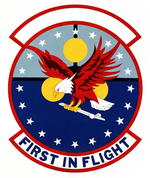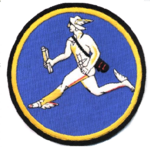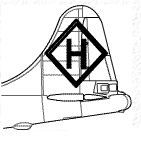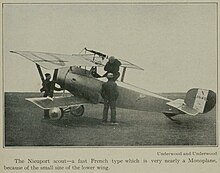911th Air Refueling Squadron
| 911th Air Refueling Squadron
Air Force Outstanding Unit Award | |
|---|---|
| Insignia | |
| 911th Air Refueling Squadron emblem[a][2] |  |
| 911th Air Refueling Squadron emblem[b][3] |  |
| Patch with old 911th Air Refueling Sq emblem |  |
| Patch with 411th Bombardment Squadron emblem[c][4] |  |
| 411th Bombardment Squadron Tail Marking (Pacific) |  |
The 911th Air Refueling Squadron is part of the
The squadron is one of the oldest in the United States Air Force. Its origins date to 15 May 1917, when it was organized at Kelly Field, Texas. The 21st Aero Squadron served in France as part of the 3d Aviation Instruction Center, American Expeditionary Forces, as a pilot training squadron during World War I.
The squadron was activated as the 21st Observation Squadron in 1923, but received few, if any, personnel before being disbanded in 1933. In 1935 a new 21st Observation Squadron was organized at
After the
It became part of
Today, the squadron operates the
History
World War I
The 911th Air Refueling Squadron traces its origins to early May 1917 when newly arrived recruits arrived at Kelly Field, Texas and were formed into 1st Company "B", 1st Regiment, Kelly Field. On 15 May these recruits became the 16th Aero Squadron. However, on 13 June it was redesignated as the 21st Aero Squadron.[5]
When the first soldiers arrived at Kelly, there were no tents or cots for them so they slept on the ground. When the first tents arrived, the men were assigned locations for them and pitched them. The men received their indoctrination into the Army as soldiers, standing guard duty and other rudimentary duties. The lack of sanitary facilities and of uniforms meant most men worked in the civilian clothing they arrived in. They slept in them without bathing until latrines and washing facilities were constructed. The men dug ditches for water mains and erected wooden buildings for barracks. On 4 August, the squadron was ordered to proceed to Scott Field, near Belleville, Illinois, arriving on the 11th. There the squadron worked with the 11th Aero Squadron, preparing the field for training. Training was received in various aircraft engines, and the men were classified as mechanics.[5]

In November the squadron received orders for overseas duty. However, an epidemic of sickness put the 21st into quarantine status. It remained quarantined until 21 December when it was cleared by the medical department to move to the Aviation Concentration Center, Garden City, Long Island, arriving on the 23d. It was not long before the squadron was ordered to proceed to the New York Port of Embarkation at Hoboken, New Jersey, where the squadron sailed for France on 4 January 1918, arriving at Saint-Nazaire on the 17th. After a few days at a rest camp, it traveled by train to the Air Service Replacement Concentration Center, located at the St. Maixent Replacement Barracks, arriving on 23 January. The 21st was classified as a school squadron, and was ordered to proceed to the 3d Aviation Instructional Center (3d AIC) at Issoudun Aerodrome. It arrived at Issoudun on 21 February.[5]
3d Aviation Instruction Center

The 3d Aviation Instruction Center was established by the Training Section, American Expeditionary Forces (AEF) to train pursuit (fighter) pilots prior to their assignment to combat on the front. The 21st Aero Squadron (School), was assigned to Issoudun Field #7, where Nieuport 28 aircraft were used for formation flying training. On 18 March, it moved to the main camp, where Fields #1, #2 and #3 were used for initial training in Nieuport 15s and 18s and 21s. When additional squadrons of mechanics arrived, the 21st concentrated at Field #3 and on maintaining the school's Nieuport 21s. The field strength grew until nearly 100 airplanes were in use, with solo flying, cross-country flying, and basic aerobatics being taught. The squadron handled all of these. The 21st's efficiency was commented on by the post commander when a record was established with 69 launches on one day, with several hundred hours of flying recorded.Training was given to many members of the pursuit squadrons of the First Army Air Service as they arrived in France; and beginning in August 1918, to new pilots for the planned Second Army Air Service as they began to arrive for training.[5]
At the time of the Armistice on 11 November, the men of the 21st Aero Squadron remained on duty completing the training of the pilots assigned to Field #3. Although it did not enter combat, the unit trained the men who went to the front and gave them the best of training so they might accomplish their work.[5]
Demobilization
The AEF was notoriously slow in returning men to the United States after the end of hostilities, and men who served on the front had priority over those who served in the rear areas. The 21st, therefore, remained at Issoudun until January 1919 when orders were received to proceed to the 1st Air Depot,
Inter-war years

On 24 March 1923, the 21st Aero Squadron was reconstituted as the 21st Observation Squadron of the
The 21st Observation Squadron (Long Range Amphibian) was activated on 1 March 1935 at
The squadron was redesignated a long range reconnaissance squadron and received early model
World War II
Heavy Bomber training
After the attack on Pearl Harbor the squadron remained in south Florida flying antisubmarine patrols against any German U-boats approaching the United States coast.[2]


On 1 February 1942, the 21st was finally assigned to the
The OTU program involved the use of an oversized parent unit to provide
B-29 Superfortress operations against Japan
The 411th Bombardment Squadron was activated the same day as a Boeing B-29 Superfortress squadron at Pratt Army Air Field, Kansas. However, a little over a month later, it was inactivated again[4] as the Army Air Forces began to reorganize its very heavy bomber groups from four squadron units to three squadron units.[14]

The squadron was activated again on 1 June 1944
After completing training the squadron deployed to the central Pacific and became part of
After the surrender of Japan the squadron dropped food and supplies to Allied prisoners of war in Japan and later flew in show of force missions.[15] It was inactivated on Guam 15 April 1946.[4]
Strategic Air Command

The 911th Air Refueling Squadron, Heavy was organized on 1 December 1958 at
In early 1960, the 4241st wing deployed its operational squadrons during the reconstruction of the Seymour Johnson runway and main taxiway. During this time the 911th operated from
The squadron transferred to the
Beginning on 1 May 1972, the 911th deployed to Andersen Air Force Base, Guam and was attached to the Strategic Wing, Provisional, 72. Its mission was to support B-52 long-range air strikes over Southeast Asia with air refueling. It remained at Andersen supporting that mission until withdrawn in July 1973, returning to Seymour Johnson.[2]
On 19 September 1985 the 911th was consolidated with the 411th Bombardment Squadron, giving the squadron a lineage and history dating to May 1917. The same year, the squadron traded in its KC-135As and received
Command changes

On 22 April 1991, the squadron was transferred to the
With the 319th, the squadron deployed KC-135Rs and crews to support tanker activities in Operation
After 11 September 2001 attacks, the 911th contributed personnel and aircraft to the
Associate unit
The 911th Air Refueling Squadron was reactivated on 12 April 2008 at Seymour Johnson Air Force Base as a geographically separated unit, the second KC-135 squadron of the
Lineage
- 21st Observation Squadron
- Organized as 1st Company "B", 1st Regiment, Kelly Field in early May 1917
- Redesignated 16th Aero Squadron c. 15 May 1917[i]
- Redesignated 21st Aero Squadron on 13 June 1917
- Demobilized on 14 April 1919
- Reconstituted and redesignated 21st Observation Squadron on 24 March 1923
- Activated in the reserve as associate to: 15th Observation Squadron
- Disbanded on 1 October 1933
- Consolidated with the 21st Reconnaissance Squadron on 2 December 1936[33]
- 411th Bombardment Squadron
- Constituted as the 21st Observation Squadron (Long Range Amphibian) on 1 March 1935
- Redesignated as 21st Reconnaissance Squadron on 1 September 1936
- Consolidated with the 21st Observation Squadron on 2 December 1936
- Redesignated 21st Reconnaissance Squadron (Long Range) on 6 December 1939
- Redesignated 21st Reconnaissance Squadron (Heavy) on 20 November 1940
- Redesignated 411th Bombardment Squadron (Heavy) on 22 April 1942
- Redesignated 411th Bombardment Squadron, Very Heavy on 28 March 1944
- Inactivated on 1 April 1944
- Activated on 1 April 1944
- Inactivated on 10 May 1944
- Activated on 1 June 1944
- Inactivated on 15 April 1946
- Consolidated with the 911th Air Refueling Squadron as the 911th Air Refueling Squadron on 19 September 1985[2]
- 911th Air Refueling Squadron
- Constituted as the 911th Air Refueling Squadron, Heavy on 28 May 1958
- Activated on 1 December 1958
- Consolidated with the 411th Bombardment Squadron on 19 September 1985
- Redesignated 911th Air Refueling Squadron on 1 July 1992
- Inactivated on 30 June 2007
- Activated on 12 April 2008[2]
Assignments
- Post Headquarters, Kelly Field, March 1917[5]
- Post Headquarters, Scott Field, 11 August 1917[5]
- Aviation Concentration Center, 23 December 1917[5]
- Air Service Replacement Concentration Center, 23 January 1918[5]
- 3d Air Instructional Center, 21 February 1918
- 1st Air Depot, January 1919[5]
- Commanding General, Services of Supply, January–March 1919[5]
- Eastern Department, 5–14 April 1919[5]
- 9th Observation Group, 24 March 1923
- 8th Division, 15 August 1927
- VIII Corps Area, 15 February 1929 – 1 October 1933[7]
- 2d Wing (later 2d Bombardment Wing), 1 March 1935 (attached to 7th Naval Districtfor operations, September 1939 – August 1940)
- Newfoundland Base Commandfor operations, May – August 1941)
- 29th Bombardment Group, attached 5 September 1941, assigned 25 February 1942 – 1 April 1944
- 29th Bombardment Group, 1 April 1944 – 10 May 1944
- 502d Bombardment Group, 1 June 1944 – 15 April 1946 (attached to 6th Bombardment Group), September 1944 – January 1945
- 4241st Strategic Wing, 1 December 1958
- 68th Bombardment Wing, 15 April 1963
- 68th Air Refueling Group (later, 68 Air Refueling Wing), 30 September 1982
- 4th Operations Group, 22 April 1991
- 319th Operations Group, 29 April 1994 – 30 June 2007
- 6th Operations Group, 12 April 2008
- 916th Operations Group, 1 November 2016
- 305th Operations Group, 31 July 2020 – present[2]
Stations
- Kelly Field, Texas, May 1917
- Scott Field, Illinois, 11 August 1917
- Aviation Concentration Center, Garden City, New York, 23 December 1917 – c. 4 January 1918
- St. Maixent Replacement Barracks, France, 23 January 1918
- Issoudun Aerodrome, France, 21 February 1918
- Bordeaux, France, c. January 1918 – c. 18 March 1919
- Hazelhurst Field, New York, c. 5–14 April 1919
- Bolling Field, District of Columbia, 1 March 1935
- Langley Field, Virginia, 1 September 1936
- 36th Street Airport, Miami, Florida, 9 September 1939 – 22 April 1941
- Newfoundland Airport, Dominion of Newfoundland, 1 May 1941 – 30 August 1941
- MacDill Field, Florida, c. 3 September 1941
- Gowen Field, Idaho, 25 June 1942 – 1 April 1944
- Pratt Army Air Field, Kansas, 1 April 1944 – 10 May 1944
- Davis-Monthan Field, Arizona, 1 June 1944
- Dalhart Army Air Field, Texas, 5 June 1944
- Grand Island Army Air Field, Nebraska, 26 September 1944 – 7 April 1945
- Northwest Field, Guam, 12 May 1945 – 15 April 1946
- Seymour Johnson Air Force Base, North Carolina, 1 December 1958
- Grand Forks Air Force Base, North Dakota, 29 April 1994 – 30 June 2007
- Seymour Johnson Air Force Base, North Carolina, 12 April 2008 – present[2]
Aircraft
- Nieuport 27 (1918)
- Nieuport 80(1918)
- Avro 504K(1918)
- Douglas O-38 (1935–1936)
- Douglas OA-4 Dolphin(1936–1937)
- Douglas YOA-5 (1936–1937)
- Martin B-10 (1936–1937)
- Douglas B-18 Bolo (1937–1941)
- Northrop A-17 Nomad(1939–1941)
- Boeing B-17 Flying Fortress (1939–1943)
- Sikorsky Y1OA-8 (1939–1941)
- Grumman OA-9 Goose(1939–1941)
- Consolidated OA-10 Catalina(1939–1941)
- Lockheed A-29 Hudson(1941–1942)
- Consolidated B-24 Liberator (1943–1944)
- Boeing B-29 Superfortress (1944–1946)
- Boeing KC-135 Stratotanker (1958–1985, 1994–2007, 2008 – 2020)
- McDonnell Douglas KC-10 Extender (1985–1994)[2]
- Boeing KC-46 Pegasus (2020–present)[citation needed]
Awards and campaigns
| Award streamer | Award | Dates | Notes |
|---|---|---|---|
Distinguished Unit Citation |
6 July 1945 – 13 July 1945 Japan | 411th Bombardment Squadron[4] | |
Air Force Outstanding Unit Award |
1 July 1965 – 30 June 1966 | 911th Air Refueling Squadron[2] | |
| Air Force Outstanding Unit Award | 1 July 1985 – 30 June 1987 | 911th Air Refueling Squadron[2] | |
| Air Force Outstanding Unit Award | 26 April 1989 – 1 April 1991 | 911th Air Refueling Squadron[2] | |
| Air Force Outstanding Unit Award | 23 April 1991 – 31 May 1993 | 911th Air Refueling Squadron[2] | |
| Air Force Outstanding Unit Award | 1 October 1993 – 30 June 1995 | 911th Air Refueling Squadron[2] | |
| Air Force Outstanding Unit Award | 1 June 1994 – 31 October 1994 | 911th Air Refueling Squadron[2] | |
| Air Force Outstanding Unit Award | 1 July 1995 – 30 June 1997 | 911th Air Refueling Squadron[2] | |
| Air Force Outstanding Unit Award | 1 July 2000 – 30 June 2002 | 911th Air Refueling Squadron[2] | |
| Air Force Outstanding Unit Award | 1 July 2002 – 30 June 2004 | 911th Air Refueling Squadron[2] | |
| Air Force Outstanding Unit Award | 1 July 2004 – 30 June 2005 | 911th Air Refueling Squadron[2] | |
| Air Force Outstanding Unit Award | 1 July 2005 – 30 June 2006 | 911th Air Refueling Squadron[2] | |
| Air Force Outstanding Unit Award | 1 July 2006 – 30 June 2007 | 911th Air Refueling Squadron[2] | |
| Air Force Outstanding Unit Award | 12 April 2008 – 30 June 2009 | 911th Air Refueling Squadron[2] | |
| Air Force Outstanding Unit Award | 1 July 2009 – 31 July 2009 | 911th Air Refueling Squadron[2] | |
| Air Force Outstanding Unit Award | 1 August 2009 – 30 June 2010 | 911th Air Refueling Squadron[2] | |
| Air Force Outstanding Unit Award | 1 July 2013 – 30 June 2014 | 911th Air Refueling Squadron[2] | |
| Air Force Outstanding Unit Award | 1 January 2016 – 31 July 2017 | 911th Air Refueling Squadron[2] | |
| Air Force Outstanding Unit Award | 1 January 2017 – 31 December 2017 | 911th Air Refueling Squadron[2] |
| Campaign Streamer | Campaign | Dates | Notes |
|---|---|---|---|
| Theater of Operations | 23 January 1918 – 1919 | 21st Aero Squadron[4] | |
| Antisubmarine | January 1942-25 June 1942 | 21st Reconnaissance Squadron (later 411th Bombardment Squadron)[4] | |
| American Theater without inscription | 7 December 1941 – 7 April 1945 | 21st Reconnaissance Squadron (later 411th Bombardment Squadron)[4] | |
| Air Offensive, Japan | 12 May 1945 – 2 September 1945 | 411th Bombardment Squadron[4] | |
| Eastern Mandates | 30 June 1945 – 1945 | 411th Bombardment Squadron[4] | |
| Western Pacific | 12 May 1945 – 2 September 1945 | 411th Bombardment Squadron[4] | |
| Defense of Saudi Arabia | 2 August 1990 – 16 January 1991 | 911th Air Refueling Squadron[2][j] | |
| Liberation and Defense of Kuwait | 17 January 1991 – 11 April 1991 | 911th Air Refueling Squadron[2] |
See also
- List of American Aero Squadrons
- List of MAJCOM wings of the United States Air Force
- List of United States Air Force air refueling squadrons
- B-17 Flying Fortress units of the United States Army Air Forces
- B-24 Liberator units of the United States Army Air Forces
- List of B-29 Superfortress operators
References
Notes
- Explanatory notes
- proper all within a diminished bordureof the fourth [mentioned color]. Endicott, p. 890.
- ^ Approved 24 July 1987.
- ^ Approved 7 August 1937. Description: On an ultramarine blue circle within a gold border a representation of the Greek god Mercury (figure proper; helmet, sandals, and purse brown; wings and scroll white.
- ^ The squadrons were consolidated in 1936. See Lineage Section for details.
- ^ It had been attached to the group since 1941.
- Aerospace Maintenance and Regeneration Center on 2 December 1992. Baugher, Joe (17 February 2023). "1958 USAF Serial Numbers". Joe Baugher. Retrieved 3 March 2023. Taken circa 1975.
- ^ Aircraft is McDonnell Douglas KC-10A Extender, serial 85-033.
- ^ The Spaatz Trophy is awarded annually to the best performing air refueling squadron in the Air Force.
- ^ LaHue, "AFHRA Factsheet" states this is the initial organization of the unit. The earlier organization was likely the source from which the squadron was manned, rather than a redesignation.
- ^ The campaign terminated in April 1944, but credit given for actual combat in the area on later dates.
- Citations
- ^ a b c Rizzo, Brandon (27 September 2007) [6 September 2007]. "BRAC changes on the horizon for North Carolina refueling wing". 916th Air Refueling Wing Public Affairs. Archived from the original on 23 February 2014. Retrieved 19 March 2014.
- ^ a b c d e f g h i j k l m n o p q r s t u v w x y z aa ab ac ad ae af ag ah ai aj ak al am an Lahue, Melissa (28 November 2022). "Factsheet 911 Air Refueling Squadron (AMC)". Air Force Historical Research Agency. Retrieved 25 December 2022.
- ^ Endicott, p. 889
- ^ a b c d e f g h i j k l Maurer, Combat Squadrons, pp. 502–503
- ^ a b c d e f g h i j k l m Series "E", Volume 4, History of the 16th–21st Aero Squadrons. Gorrell's History of the American Expeditionary Forces Air Service, 1917–1919, National Archives, Washington, D.C.
- ^ Series "D", Weekly Statistical Reports of Air Service Activities, October 1918 – May 1919. Gorrell's History of the American Expeditionary Forces Air Service, 1917–1919, National Archives, Washington, D.C.
- ^ a b c d e f Clay, pp. 1387–1388
- ^ Clay, p. vi
- ^ a b Maurer, Combat Units, pp. 82–83
- ^ a b Craven, & Cate (eds.), Vol. VI, p. xxxvi
- ^ Craven & Cate, The Organization and its Responsibilities, Chapter 2 The AAF p. 75
- ^ Maurer, Combat Units, p. 7
- ^ "Abstract, History Gowen Field, ID Feb 1945". Air Force History Index. Retrieved 28 March 2014.
- ^ Compare "Abstract, History 468 Bombardment Group (Very Heavy) Oct 1944". Air Force History Index. Retrieved 29 March 2014. (reorganizing from four bombardment squadrons and four maintenance squadrons to three bombardment squadrons). Apparently, the 29th group never organized its maintenance squadrons.
- ^ a b c d Maurer, Combat Units, p. 367
- ^ "Abstract, History 502 Bombardment Group Sep 1944". Air Force History Index. Retrieved 29 March 2014.
- ^ "Abstract, History 502 Bombardment Group Jul 1945". Air Force History Index. Retrieved 29 March 2014.
- ^ "Abstract (Unclassified), Vol 1, History of Strategic Air Command, Jan–Jun 1957 (Secret)". Air Force History Index. Retrieved 4 March 2014.
- ^ "Abstract (Unclassified), History of the Strategic Bomber since 1945 (Top Secret, downgraded to Secret)". Air Force History Index. 1 April 1975. Retrieved 4 March 2014.
- ^ "Abstract, History 4241 Strategic Wing Aug 1959". Air Force History Index. Retrieved 3 April 2014.
- ^ "Abstract, History 822 Air Division Jan–Feb 1960". Air Force History Index. Retrieved 3 April 2014.
- ^ "Abstract, History 822 Air Division Jul–Aug 1960". Air Force History Index. Retrieved 3 April 2014.
- ^ "Abstract, History 4241 Strategic Wing Sep 1961". Air Force History Index. Retrieved 3 April 2014.
- ^ Ravenstein, p. 108
- ^ "Abstract, Volume 1 History 68 Bombardment Wing Oct–Dec 1966". Air Force History Index. Retrieved 3 April 2014.
- ^ a b "Abstract, History 68 Air Refueling Wing Jul 1990 – Apr 1991". Air Force History Index. Retrieved 3 April 2014.
- ^ History of Grand Forks Air Force Base and the 319th Air Refueling Wing, p. 15
- ^ a b "Abstract, History 4 Wing Jan–Jun 1994". Air Force History Index. Retrieved 3 April 2014.
- ^ History of Grand Forks, p. 21
- ^ History of Grand Forks, pp. 20–22
- ^ "911th Air Refueling Squadron to inactivate". Grand Forks Air Force Base. 7 June 2007. Retrieved 20 March 2014.
- ^ Lambert, Sr Amn Whitney (18 March 2011) [17 March 2011]. "What is the 911th ARS?". 4th Fighter Wing Public Affairs. Retrieved 20 March 2014.
- ^ Except as indicated, lineage is in Lahue, "AFHRA Factsheet".
Bibliography
![]() This article incorporates public domain material from the Air Force Historical Research Agency
This article incorporates public domain material from the Air Force Historical Research Agency
- Clay, Steven E. (2011). US Army Order of Battle 1919–1941 (PDF). Vol. 3 The Services: Air Service, Engineers, and Special Troops 1919–1941. Fort Leavenworth, KS: Combat Studies Institute Press. OCLC 637712205. Archived from the original(PDF) on 27 September 2013. Retrieved 16 October 2012.
- Endicott, Judy G. (1998). Active Air Force Wings as of 1 October 1995 and USAF Active Flying, Space, and Missile Squadrons as of 1 October 1995 (PDF). Air Force History and Museums Program. Washington, DC: Office of Air Force History. ASIN B000113MB2. Retrieved 2 July 2014.
- Gorrell, Col. Edgar S. (1974). History of the American Expeditionary Forces Air Service, 1917–1919. Series D, E. Washington, DC: National Archives and Records Service, General Services Administration. OCLC 215070705.
- Maurer, Maurer, ed. (1983) [1961]. Air Force Combat Units of World War II (PDF) (reprint ed.). Washington, DC: Office of Air Force History. LCCN 61060979.
- Maurer, Maurer, ed. (1982) [1969]. Combat Squadrons of the Air Force, World War II (PDF) (reprint ed.). Washington, DC: Office of Air Force History. OCLC 72556.
- Ravenstein, Charles A. (1984). Air Force Combat Wings, Lineage & Honors Histories 1947–1977. Washington, DC: Office of Air Force History. ISBN 0-912799-12-9.
- History of Grand Forks Air Force Base and the 319th Air Refueling Wing (PDF). Grand Forks AFB, SD: Wing Command Section, 319th Air Refueling Wing. 2007. Archived from the original (PDF) on 28 December 2013.
Further reading
- Maurer, Maurer (1987). Aviation in the U.S. Army, 1919–1939 (PDF). Washington, DC: Office of Air Force History, United States Air Force. OCLC 15661556. Retrieved 20 July 2013.
- Maurer, Maurer (1978). The US Air Service in World War I (PDF). Vol. 1. Washington, DC: Office of Air Force History, United States Air Force. ISBN 978-1477602-74-4. Archived from the original(PDF) on 27 September 2013. Retrieved 19 March 2014.
- Smith, Richard K. (1998). Seventy-Five Years of Inflight Refueling: Highlights, 1923–1998 (PDF). Air Force History and Museums Program. Washington, DC: Government Printing Office. Retrieved 13 August 2013.






